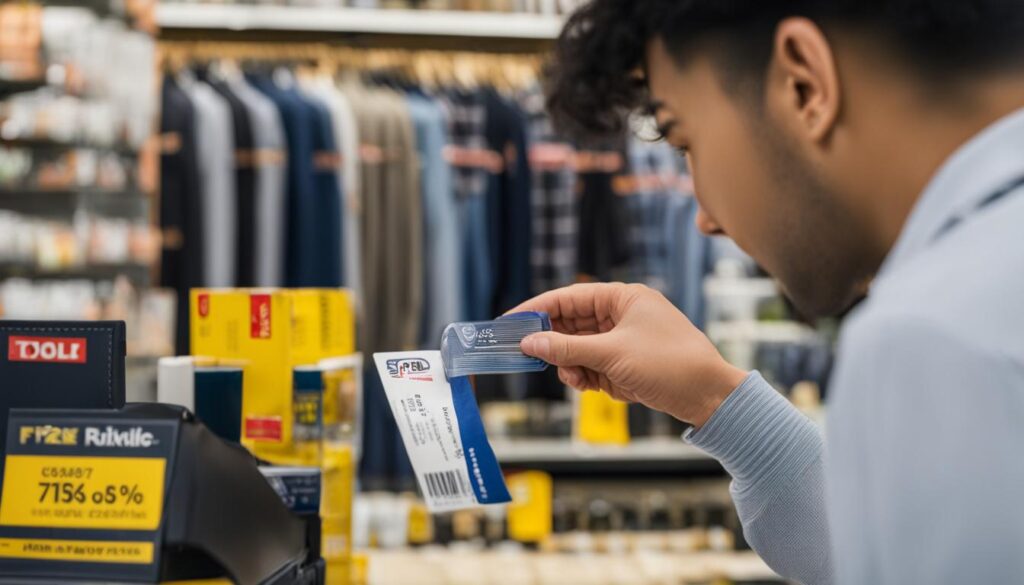The anchoring bias is a powerful psychological phenomenon that profoundly influences consumer perception and decision-making when it comes to pricing. By understanding and leveraging this bias, businesses can strategically shape customer behavior and optimize their pricing strategies. In this article, we will explore the concept of the anchoring bias, its impact on consumer behavior, and its role in pricing strategy.
Key Takeaways:
- The anchoring bias refers to the tendency to heavily rely on the first piece of information encountered when making a decision, especially in pricing.
- Understanding the anchoring bias is crucial for businesses to influence customer perception and guide purchasing decisions.
- By setting appropriate anchor prices and utilizing strategies that tap into the anchoring bias, businesses can optimize their pricing strategies and increase sales.
- The anchoring bias plays a significant role in shaping price perception and can create the perception of a bargain even when the actual price is still relatively high.
- Anchoring bias can be effectively utilized in pricing strategies to guide customer behavior and enhance the customer experience.
Understanding the Anchoring Bias
The anchoring bias is a cognitive phenomenon rooted in behavioral economics and cognitive psychology. It refers to the tendency for people to rely heavily on the first piece of information encountered when making judgments or decisions. This bias has a significant impact on consumer behavior and pricing strategies.
When it comes to the anchoring bias, external and internal anchors play a crucial role. External anchors can include price comparisons or market benchmarks, while internal anchors are influenced by personal preferences and beliefs. For example, if a consumer sees a high-priced item first, subsequent options may appear more affordable, even if they are still relatively expensive.
Understanding the anchoring bias is essential for businesses looking to optimize their pricing strategies and influence consumer behavior. By strategically setting anchor prices and utilizing techniques that tap into the anchoring effect, marketers can shape customer perception, guide purchasing decisions, and enhance sales.
To better understand the anchoring bias in action, let’s explore some real-world examples in the following table:

Famous Examples of the Anchoring Bias
“The human mind is exquisitely sensitive to the relationship between any one thing and some other. Without comparative points, no evaluation can be made, no decision reached. Everything becomes relative.” – Richard Thaler, Nobel Prize-winning economist
As shown in the table, the Williams-Sonoma bread maker and Apple’s product lineup are two well-known examples of how companies leverage the anchoring bias in their marketing and pricing strategies. These examples highlight the power of the anchoring effect in shaping consumer perception of value and influencing purchasing decisions.
How the Anchoring Bias Works in Pricing
The anchoring bias is a powerful psychological phenomenon that influences pricing decisions and customer perception. Understanding how the anchoring bias works in pricing can help businesses effectively shape consumer behavior and optimize their pricing strategies.
When customers encounter a high-priced item as their initial anchor, it sets a reference point for subsequent options. As a result, even if the subsequent options are still relatively expensive, they may appear more affordable in comparison. This can create a perception of value and make customers more inclined to make a purchase.
For example, let’s consider the Williams-Sonoma bread maker. The introduction of a higher-priced model created an anchor that made the original model seem more reasonably priced. As a result, sales of the original model increased. Apple also utilizes the anchoring bias in their pricing strategies by offering multiple storage options for iPhones. By setting higher anchor prices for increased storage capacity, they influence customers to perceive the lower storage options as more affordable.

Table: Examples of the Anchoring Effect in Pricing
| Product/Service | Anchor | Effect |
|---|---|---|
| Williams-Sonoma bread maker | Higher-priced model | Increase sales of original model |
| Apple iPhones | Higher-priced storage options | Perception of lower storage options as more affordable |
By leveraging the anchoring bias in pricing strategies, businesses can shape customer perception, influence purchasing decisions, and optimize their sales. It’s important to set appropriate anchor prices that create a perception of value and guide customers towards desired options. Whether it’s through offering tiered pricing options, utilizing psychological pricing techniques, or emphasizing original prices in sales promotions, understanding and utilizing the anchoring bias can be a powerful tool for businesses to achieve their pricing goals.
Anchoring Bias in Marketing Examples
The anchoring bias is commonly used in marketing to influence consumer behavior and shape purchasing decisions. Marketers strategically utilize this bias to set reference points or anchors that guide consumer perception and create favorable comparisons. By understanding how the anchoring bias works, marketers can effectively leverage it in their pricing strategies and marketing tactics.
One example of the anchoring bias in marketing is the Williams-Sonoma bread maker. When Williams-Sonoma introduced a higher-priced, deluxe model of their bread maker, sales of the original model significantly increased. The higher-priced model served as an anchor, making the original model seem more affordable and enticing to consumers. This example demonstrates how the presence of an anchor can influence consumer choices and drive sales.
Another company that strategically applies the anchoring bias is Apple. Through their pricing strategies, such as offering multiple storage options for iPhones, Apple creates anchors that influence the perceived value of their products. By presenting higher-priced alternatives, Apple makes their lower-priced options appear more reasonable and attractive to consumers. This approach helps shape consumer perception and encourages purchasing decisions.
“The presence of an anchor can significantly impact consumer decision-making. By strategically setting higher anchor prices, businesses can make lower-priced options seem like a better deal, leading to increased sales.”
The anchoring bias can even be observed in The Economist’s subscription options experiment. The magazine offered three subscription choices: an online-only subscription, a print-only subscription, and a print + online subscription. By introducing the print-only option, which was priced the same as the print + online option, The Economist created an anchor that made the print + online option seem like a better value. As a result, the majority of consumers chose the print + online subscription, influenced by the presence of the anchor.
In summary, the anchoring bias is a powerful tool in marketing that can significantly influence consumer behavior and purchasing decisions. Examples such as the Williams-Sonoma bread maker, Apple’s pricing strategies, and The Economist’s subscription options illustrate how anchors can shape consumer perception and guide choices. By understanding and applying the anchoring bias in marketing, businesses can effectively influence consumer behavior and optimize their pricing tactics.
| Marketing Example | Anchoring Bias Applied |
|---|---|
| Williams-Sonoma bread maker | Higher-priced model serves as an anchor, making the original model appear more affordable and attractive. |
| Apple’s pricing strategies | By offering higher-priced alternatives, Apple makes their lower-priced options seem more reasonable and appealing. |
| The Economist’s subscription options | Introducing a print-only option at the same price as the print + online option creates an anchor that makes the latter appear as a better value. |

The Power of Anchoring in Pricing Perception
The anchoring bias plays a significant role in shaping price perception. When consumers encounter a reference point or anchor, such as a high price, they tend to judge other prices relative to that anchor. This bias can create the perception of a bargain when a price is lower than the anchor, even if the actual price is still high. For businesses, understanding and leveraging the power of anchoring can be a valuable tool in influencing consumer decision-making and maximizing sales.
One common strategy that taps into the anchoring bias is the use of “charm pricing,” which involves setting prices that end in “.99.” This psychological pricing technique makes a price appear significantly lower than a rounded figure, creating a perception of a better deal. For example, pricing an item at $9.99 instead of $10 can make it seem more affordable and appealing to consumers, even though the difference is minimal. By using charm pricing, businesses can take advantage of the anchoring effect and influence customer perception of value.
In addition to charm pricing, businesses can create anchors in pricing strategies by strategically setting higher and lower anchor prices. This can be achieved through tiered pricing options, where customers are presented with various pricing tiers that create a reference point for comparison. For instance, offering a basic, standard, and premium pricing option for a product or service can influence customers to opt for the mid-tier option by making it seem like the best value for their money. By setting appropriate anchor prices and utilizing psychological pricing techniques, businesses can guide consumer perception and increase the likelihood of purchase.
| Example of Charm Pricing | Price |
|---|---|
| Product A | $9.99 |
| Product B | $10.00 |
| Product C | $10.99 |
The power of anchoring in pricing perception can be summarized as:
- Setting an anchor or reference point influences how consumers judge other prices.
- Charm pricing, with prices ending in “.99,” taps into the anchoring bias and influences consumer perception of value.
- Creating anchor prices through tiered pricing options can guide consumer decision-making and increase the likelihood of purchase.
Creating Anchors in Pricing Strategies
The anchoring bias is a powerful psychological phenomenon that can be harnessed in pricing strategies to influence consumer behavior. By strategically setting anchor prices, businesses can guide customers towards desired products or services and increase sales. There are various techniques and sales tactics that can be used to create anchors and leverage the anchoring bias effectively.
Tiered Pricing Options
One effective way to create anchors is by offering tiered pricing options. By presenting customers with different levels of product or service offerings at varying price points, businesses can set a higher anchor price for the top-tier option. This higher-priced anchor can make the mid-tier or lower-tier options appear more affordable in comparison, influencing customers to make the desired purchase.
Highlighting Original Prices
Another strategy is to highlight the original prices in sales promotions. By displaying the original price alongside the discounted price, businesses can create an anchor point that emphasizes the perceived value of the discounted offer. This can make customers more likely to view the discounted price as a bargain and motivate them to make a purchase.
Psychological Pricing Techniques
Psychological pricing techniques can also leverage the anchoring bias to shape consumer perception. For example, using charm pricing strategies, which involve setting prices at just below a whole number, such as $9.99 instead of $10.00, can create an anchor of a lower price point. This lower anchor can make the price seem more affordable and attractive to customers, influencing their decision to purchase.
By understanding the power of the anchoring bias and implementing these pricing tactics, businesses can effectively shape consumer perception, increase sales, and optimize their pricing strategies.

| Technique | Description |
|---|---|
| Tiered Pricing Options | Offering different levels of products or services at varying price points to set higher anchor prices and influence purchase decisions. |
| Highlighting Original Prices | Showcasing the original price alongside a discounted price to create an anchor point that emphasizes perceived value and drives purchasing behavior. |
| Psychological Pricing Techniques | Utilizing strategies like charm pricing, where prices are set just below a whole number, to create lower anchors and influence price perception. |
Anchoring Bias and Decision Deviation
The anchoring bias, a cognitive phenomenon, can lead to decision deviation in consumer behavior. When making judgments and choices, people tend to heavily rely on the initial anchor, or the first piece of information encountered. This bias can significantly impact consumer price evaluations and subsequent decision-making processes. By understanding and leveraging the anchoring effect, marketers can mitigate decision deviation and ensure more accurate pricing judgments.
Consumer perception of price is greatly influenced by the anchoring bias. The initial anchor sets a reference point against which other prices are judged. Research has shown that even if subsequent prices are still relatively high, they may appear more affordable if a higher-priced option is encountered first. This can create the perception of a bargain when prices are lower than the anchor. Marketers can strategically set anchor prices to shape consumer perception and guide purchasing decisions.
In order to align prices with consumer expectations, it is crucial to set appropriate anchor prices. By framing prices in a way that considers the anchoring bias, businesses can effectively influence price judgments. Additionally, understanding the psychology behind anchoring can help marketers design pricing strategies that tap into this bias. This can involve creating reference points, utilizing psychological pricing techniques, and highlighting higher-priced alternatives to make lower-priced options seem more attractive.
| Anchor Price | Product | Price |
|---|---|---|
| High anchor | Deluxe Model | $199.99 |
| Low anchor | Standard Model | $99.99 |
| Low anchor | Basic Model | $49.99 |
Take the example of a product with multiple pricing options. By introducing a higher-priced deluxe model as an anchor, the standard model priced at $99.99 may appear more affordable and enticing to consumers. Similarly, the basic model priced at $49.99 may seem like a bargain compared to the higher anchor price. Understanding the anchoring bias can help businesses optimize their pricing strategies and guide consumers towards their desired offerings.
The Anchoring Effect in Customer Experience
The anchoring effect, a powerful psychological bias, extends its influence beyond pricing decisions and impacts customer experience perception. External and internal anchors shape how consumers perceive the value of a product or service, influencing their purchasing decisions. For instance, the presence of higher anchor prices in a store can make lower-priced options seem more affordable and attractive. Understanding and leveraging the anchoring effect in customer experience can significantly enhance customer satisfaction and drive purchasing decisions.
When designing customer experiences, businesses should consider the impact of anchoring and use it strategically to shape perception. By setting appropriate anchor prices and creating reference points, businesses can guide consumers towards desired options, ultimately influencing their decision-making process. Leveraging the anchoring effect can be achieved through techniques such as tiered pricing options, sales promotions that highlight original prices, and psychological pricing strategies.
“The presence of higher anchor prices in a store can make lower-priced options seem more affordable and attractive.”
Furthermore, the anchoring effect can be utilized to create a sense of value and exclusivity. By employing anchoring strategies, businesses can position their offerings in a way that aligns with customer expectations and enhances their perception of the product or service. This can be achieved through the careful selection of anchor prices and the strategic framing of prices in relation to the anchor. Understanding how the anchoring effect influences customer experience perception can empower businesses to optimize their pricing strategies and create memorable customer experiences.
Example of Anchoring Effect in Customer Experience:
Table: Anchoring Effect in Pricing Perception
| Anchor Price | Product Option 1 | Product Option 2 |
|---|---|---|
| $99.99 | $79.99 | $49.99 |
| $149.99 | $129.99 | $99.99 |
| $199.99 | $179.99 | $149.99 |
In the table above, the anchor prices significantly influence the perception of value for different product options. When the anchor price is set higher, the lower-priced options appear more attractive and affordable in comparison. This showcases how the anchoring effect can shape pricing perception and influence customer decision-making towards the desired product option.
By understanding and leveraging the anchoring effect in customer experience, businesses can create a compelling pricing strategy that enhances customer perception and drives purchasing decisions. Utilizing appropriate anchor prices, setting reference points, and strategically framing prices can optimize pricing strategies and contribute to a positive customer experience.
Using Anchoring Bias in Pricing Strategies
Understanding and leveraging the anchoring bias can be a powerful tool in pricing strategies to influence customer behavior. By strategically setting anchor prices, businesses can shape customer perceptions and guide their purchasing decisions towards desired options. One effective strategy is to highlight higher-priced alternatives to make a lower-priced option appear more attractive.
Psychological pricing techniques, such as using prices ending in “.99” or emphasizing discounts, can tap into the anchoring bias and influence customer perception of value. Creating reference points that align with customer expectations is also key. For example, offering tiered pricing options can give customers a range of choices to anchor their decision-making process.
It is important to consider consumer behavior when leveraging the anchoring bias in pricing strategies. Different customer segments may respond differently to anchor prices, and understanding their preferences and expectations can help businesses tailor their approach. Market research and customer data analysis can provide valuable insights into customer behavior and the effectiveness of pricing strategies.
Examples of Anchoring Bias in Pricing Strategies
“When we introduced our premium package at a higher price point, we saw an increase in sales for our mid-tier package. Customers perceived it as a better value compared to the premium option, even though the price remained the same.”
| Product | Original Price | Discounted Price |
|---|---|---|
| Product A | $99.99 | $79.99 |
| Product B | $129.99 | $99.99 |
| Product C | $149.99 | $119.99 |
By presenting the higher-priced product first (Product C), customers may perceive the discounted price of Product A as a better deal, even though it is still relatively high. This pricing strategy leverages the anchoring bias to guide customer perception and increase sales.
In conclusion, the anchoring bias can be a valuable tool in pricing strategies to influence customer behavior. By setting appropriate anchor prices, utilizing psychological pricing techniques, and understanding consumer preferences, businesses can optimize their pricing strategies and increase sales.
Conclusion
The anchoring bias is a powerful psychological phenomenon that significantly influences pricing strategies and consumer behavior. By understanding and leveraging the anchoring effect, businesses can shape customer perception, guide purchasing decisions, and optimize pricing strategies to achieve maximum impact.
Setting appropriate anchor prices is key to utilizing the anchoring bias effectively. By strategically introducing higher-priced options, businesses can make lower-priced alternatives appear more attractive, thereby increasing sales and enhancing customer satisfaction. Psychological pricing techniques, such as “charm pricing” with prices ending in “.99”, tap into the anchoring bias and influence consumer perception of value.
Moreover, the anchoring effect plays a crucial role in customer experience perception. External and internal anchors can influence how consumers evaluate the value of a product or service. By incorporating high anchor prices and creating reference points in the customer experience, businesses can make lower-priced options seem more affordable, influencing purchasing decisions in their favor.
In conclusion, harnessing the power of the anchoring bias in pricing is a valuable tool for businesses to navigate price point pitfalls and optimize their success in the market. By utilizing appropriate anchor prices, leveraging psychological pricing techniques, and incorporating the anchoring effect in the customer experience, businesses can effectively shape consumer behavior, enhance price perception, and ultimately drive sales.
FAQ
What is the anchoring bias?
The anchoring bias is a psychological phenomenon that influences consumer perception and decision-making. It refers to the tendency to rely heavily on the first piece of information encountered when making a decision.
How can marketers use the anchoring bias?
Marketers can use the anchoring bias to shape customer perception and influence purchasing decisions. By setting higher anchor prices, lower-priced options can appear more affordable in comparison.
How does the anchoring bias affect pricing decisions?
The anchoring bias influences pricing decisions by shaping customer perception of value. When a high-priced item is encountered first, subsequent options may appear more affordable, even if they are still relatively expensive.
Can you provide examples of the anchoring bias in marketing?
Examples of the anchoring bias in marketing include the Williams-Sonoma bread maker, Apple’s product lineup, and The Economist’s subscription options.
How does the anchoring bias impact price perception?
The anchoring bias creates the perception of a bargain when a price is lower than the anchor, even if the actual price is still high. This can be seen in the use of “charm pricing” with prices ending in “.99”.
How can businesses utilize the anchoring bias in pricing strategies?
Businesses can utilize the anchoring bias in pricing strategies by setting appropriate anchor prices, highlighting higher-priced alternatives, and utilizing psychological pricing techniques.
Does the anchoring bias lead to decision deviation?
Yes, the anchoring bias can lead to decision deviation as people tend to heavily rely on the initial anchor when making judgments and choices.
How does the anchoring bias influence customer experience perception?
The presence of high anchor prices can make lower-priced options seem more affordable, influencing how consumers perceive the value of a product or service.
How can businesses effectively use the anchoring bias in pricing strategies?
By setting appropriate anchor prices and utilizing strategies that tap into the anchoring bias, businesses can shape customer perception, guide purchasing decisions, and optimize pricing strategies.
What is the significance of the anchoring bias in pricing and consumer behavior?
Understanding and leveraging the anchoring bias is crucial for pricing strategies and consumer behavior analysis. It helps businesses navigate price point pitfalls and maximize their success in the market.
How Does Scarcity Influence our Shopping Behavior?
Scarcity is a powerful force that affects our shopping behavior, as supported by the psychology of scarcity and spending. When something becomes scarce or limited, our desire for it increases. Retailers use this principle to create a sense of urgency and encourage impulse purchases. Limited-time offers, exclusive items, and countdowns trigger our fear of missing out, driving us to buy even if we don’t necessarily need or want the item. Understanding this psychology helps marketers capitalize on scarcity to influence our shopping decisions.


Pingback: Trendsetting or Trend Following: Business Strategies and the Bandwagon Effect – Straight Fire Money